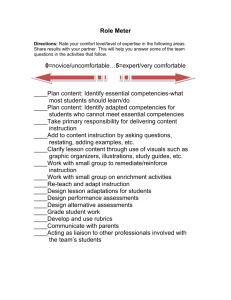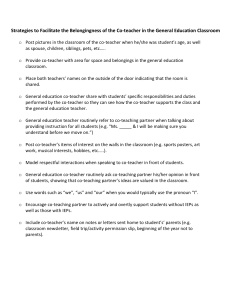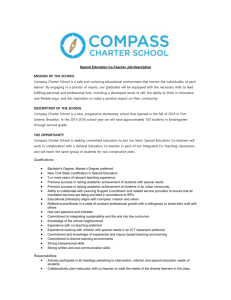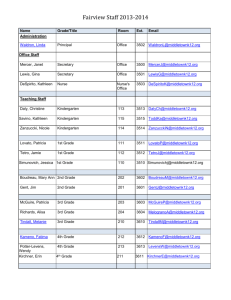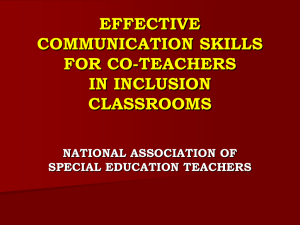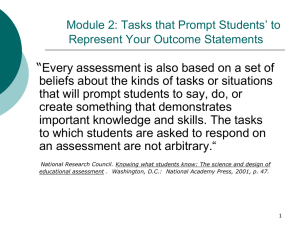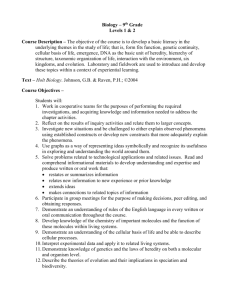Cooperative Teacher Interview 511
advertisement
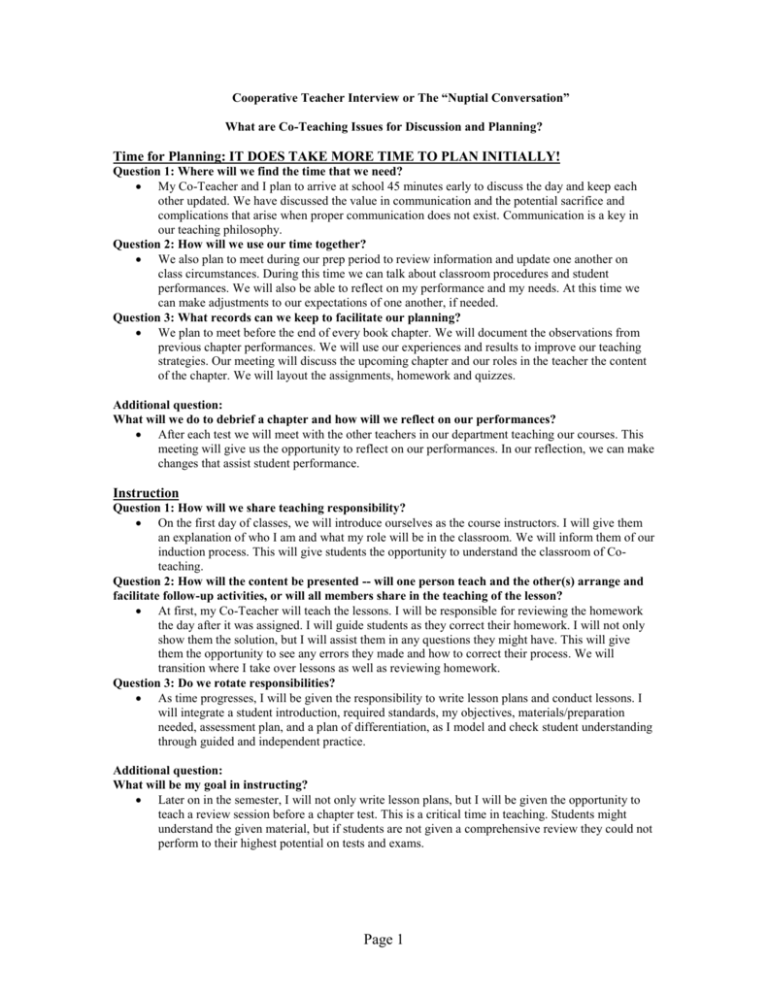
Cooperative Teacher Interview or The “Nuptial Conversation” What are Co-Teaching Issues for Discussion and Planning? Time for Planning: IT DOES TAKE MORE TIME TO PLAN INITIALLY! Question 1: Where will we find the time that we need? My Co-Teacher and I plan to arrive at school 45 minutes early to discuss the day and keep each other updated. We have discussed the value in communication and the potential sacrifice and complications that arise when proper communication does not exist. Communication is a key in our teaching philosophy. Question 2: How will we use our time together? We also plan to meet during our prep period to review information and update one another on class circumstances. During this time we can talk about classroom procedures and student performances. We will also be able to reflect on my performance and my needs. At this time we can make adjustments to our expectations of one another, if needed. Question 3: What records can we keep to facilitate our planning? We plan to meet before the end of every book chapter. We will document the observations from previous chapter performances. We will use our experiences and results to improve our teaching strategies. Our meeting will discuss the upcoming chapter and our roles in the teacher the content of the chapter. We will layout the assignments, homework and quizzes. Additional question: What will we do to debrief a chapter and how will we reflect on our performances? After each test we will meet with the other teachers in our department teaching our courses. This meeting will give us the opportunity to reflect on our performances. In our reflection, we can make changes that assist student performance. Instruction Question 1: How will we share teaching responsibility? On the first day of classes, we will introduce ourselves as the course instructors. I will give them an explanation of who I am and what my role will be in the classroom. We will inform them of our induction process. This will give students the opportunity to understand the classroom of Coteaching. Question 2: How will the content be presented -- will one person teach and the other(s) arrange and facilitate follow-up activities, or will all members share in the teaching of the lesson? At first, my Co-Teacher will teach the lessons. I will be responsible for reviewing the homework the day after it was assigned. I will guide students as they correct their homework. I will not only show them the solution, but I will assist them in any questions they might have. This will give them the opportunity to see any errors they made and how to correct their process. We will transition where I take over lessons as well as reviewing homework. Question 3: Do we rotate responsibilities? As time progresses, I will be given the responsibility to write lesson plans and conduct lessons. I will integrate a student introduction, required standards, my objectives, materials/preparation needed, assessment plan, and a plan of differentiation, as I model and check student understanding through guided and independent practice. Additional question: What will be my goal in instructing? Later on in the semester, I will not only write lesson plans, but I will be given the opportunity to teach a review session before a chapter test. This is a critical time in teaching. Students might understand the given material, but if students are not given a comprehensive review they could not perform to their highest potential on tests and exams. Page 1 Student Behavior Question 1: If we could each have only three class rules, what would those be? My Co-Teacher has already laid out student expectations in his rubric and clearly communicated them to me. I completely align with these rules and expectations. Success is a key in our teaching philosophy. Students are expected to be prepared, respectful, honest, responsible and attentive. We will build are students up as they fulfill our expectations. When students fulfill these expectations, they are headed toward success regardless of their academic standings. Question 2: How will we be consistent in dealing with behavior? We will clearly discuss our expectations. Failure to adhere to the class rules will result in a warning, change of seat, student conference, parent conference, detention, written assignment , community service, confiscation of electronic equipment or referral. We will keep each other accountable and reasonable as we deal with students’ behavior. Additional Questions: What is one way we will regulate behavior? If a student were to be absent it is their responsibility to figure out the homework and complete assignments before they return to class. Student can find the assignments online or through their “study buddies”. How will we encourage students’ behavior to align with the school’s expectations? Students are discouraged from being tardy. We will follow the school’s tardy policy. The course moves quickly and covers a lot of material. We want to encourage our students to be invested in their academic performance. Communication Question 1: How will we explain this collaborative teaching arrangement to the parents? I will be introduced to the parents on Back to School Night. This introduction will provide opportunity for the parents to get to know me as it will permit communication between myself and the parents of students. Parents will understand who I am and what my role is. As a result, when students mention me, to their parents, I will hold a position of validity and authority. Page 2 Question 2: Who will communicate with parents? Will there be shared responsibility for communication with parents of students with identified special education and other specialized needs, or will particular members of co-teaching team have this responsibility? My Co-Teacher and I will send out an email to update the parents on their students’ performances. Parents will not only be updated when their students perform poorly. Parents will also be notified when students perform well. When students are recognized for their performance, they become invested in expectations that are placed on them and therefore execute all that is before them. Question 3: Who will communicate with students? We will build relationships with the students. We both value students and where they are coming from. We expect students to come to class balancing all of life. We want to offer ourselves and our classroom to be accessible to students to support them and their endeavors. Additional Question: How will we respond if I feel overwhelmed? My Co-Teacher has been very comforting. He has high expectations of me. He wants me to grow and learn. He has been honest with his expectations and reasonable in delivery. He has said, if I feel I have too much expected of me, he will reorganize accordingly. Therefore, it is my responsibility to communicate my needs throughout the various stages of the induction process. Evaluation Question 1: How will we monitor students' progress? My Co-Teacher and I will assess student performance throughout the lesson. In the beginning I, as a Supportive Co-Teacher, will walk the room and assess student performance. If I see students struggling, I will inquire about their understanding. Together we will work toward understanding the material. Intentional and comprehensive teaching is a key in our teaching philosophy. Question 2: How will we assess and grade student performance? Students will be required to correct their homework in pen. After correcting the homework, they will turn it in. The pen corrections will allow myself and my Co-Teacher to see where and how students are struggling with the information. We will share grading of the tests. He will grade the first tests. As I transition in my understandings, I will be responsible for grading tests. We will assess based on students on going performances. It will be great to have my Co-Teacher’s perspective as we reflect on the results. Additional Questions: How will we periodically determine what students are understanding? Throughout each chapter we will assign quizzes. The goal of these quizzes is to keep students comprehending the covered material for the chapter test. The quizzes will be announced. Announced quizzes give students the opportunity to adequately prepare and therefore preform to the best of their potential. Through the results of these quizzes we will be given a structured understanding of what the students are comprehending. How will students be able to determine their grade? Students will be able to follow their academic progress online. Students will see their grades. My Co-Teacher and I are determined to post assignments to our online grade book as soon as we can. As we keep our grade book up to date, we will have an idea of our students’ understanding. This will also keep students interested in their progress. What will we do if students continue to misunderstand information? My Co-Teacher and I are both interested in seeing students succeed. We are both willing to spend time outside of class working with students one on one and in group tutoring. We will offer students who are struggling with information our lunch and after school hours to work with them. Logistics Question 1: How will we refer to each other in front of the students? My Co-Teacher and I will refer to each other as equal contributors. We will introduce ourselves to the students by our last names and will be sure to use those names throughout the class sessions. Page 3 When working together in front of students we will respect each other’s input. We will allow one another to interject as needed for clarification. This will reinforce our explination of Co-Teaching. Question 2: How will teacher space be shared? We will share our space equally. I have received keys from the office to my Co-Teacher’s classroom. I not only have access to his classroom, but to his filling cabinets. This access will provide me with a least restrictive environment where I will be able to make the classroom my own. Question 3: How will the room be arranged? My Co-Teacher has arranged the room where the students face toward the white boards. This is the most practical in a math classroom. Students will not have to turn their heads or desks to follow the class lecture. This will provide the most structure and least opportunity for distraction. Question 4: How will a balance of decision-making power be maintained among co-teachers? My Co-Teacher and I are looking forward to working with one another. He is excited to let me take over the classroom. When I have shown and expressed my decision making attributes, he has been supportive. Not only has he been supportive, but he has guided me toward making decisions on my own. Timeline for shift from CT to TC and “solo” teaching? Additional Questions: Question 1: How will we initially develop a positive learning environment? From the beginning, we will develop a positive learning environment by supporting one another. My teacher will provide opportunities for me to interject. This will show students how to work collaboratively. We will not interrupt each other. We will work toward building a co-dependent relationship. This will allow us to use our strengths toward classroom procedures. Question 2: When will we inform the students about the transition? We will inform the students about my transitions at the beginning of the semester. This will allow transitions to happen naturally. When we are striving for a new personal achievement or transitioning to further responsibilities, we will communicate with the students what we are doing. This will prevent students from being surprised or caught off guard by any of our transitions. Question 3: When will be our goal for me to start writing lesson plans? We are going to try to follow the calendar of progress and assignments given by the Single Subject Handbook. This means I will be writing lesson plans by week 3. As this time I will not begin teaching my lessons. This will provide opportunity for my Co-Teacher to evaluate them and opportunity for me to develop them for later on in the semester when I am teaching lessons. Other Additional Questions: Question 1: How should we make up for me not being in class on Mondays? We will explain my absence to the students at the beginning of the year. Students will not expect to see me and therefore will not be disappoint when I am not there. Our goal is for students to feel comfortable with both of our teaching styles. My Co-Teacher plans to be flexible with my schedule. Question 2: How can I help with the website? We will constantly post our assignments to the web. I showed my Co-Teacher how to embed links to assignments on Google Docs. I will write a blog to keep parents interested and updated in their students’ development throughout the semester. Additional Prompt: Correspondence Additional Questions: Question 1: Will I have an email address where I can correspond with others around the district? Yes. We are working with my OSL(On Site Lesion). She will provide the directions and procedures on how to set up a district email. Question 2: Can we access students’ performance in other classes? Yes. The district uses an online resource called Ares. This resource provides the ability to access and configure student grades, attendance and class schedules. When we notice student patterns we Page 4 can look on Ares to see if they are falling into some kind of consistency or inconsistency. This will give us a better understanding of their performance outside of our classroom. Materials from or adapted by Dr. E. Garza from: Villa, Thousand, & Nevin (2008) A guide to co-teaching: Practical tips for facilitating student learning (2nd ed.). Thousand Oaks, CA: Corwin Press Page 5 Sample “Nuptial Conversation” Issues for Discussion and Planning Time for Planning How much time do we need? Where will we find the time that we need? How will we use our time together? What records can we keep to facilitate our planning? Instruction What content will we include? Who plans for what content? How will we share teaching responsibility? Who adapts the curriculum and instructional and assessment procedures for select students? What are our strengths in the area of instruction and assessment? How will the content be presented -- will one person teach and the other(s) arrange and facilitate follow-up activities, or will all members share in the teaching of the lesson? How will we arrange to share our expertise? How can we arrange to observe one another and practice peer coaching? Do we rotate responsibilities? How will we assess the effectiveness of our instruction? Student Behavior If we could each have only three class rules, what would those be? Who decides on the disciplinary procedures? Who carries out the disciplinary procedures and delivers the consequences? How will we be consistent in dealing with behavior? How will we proactively addressing behavior? Communication What types and frequency of communication do we each like to have with parents? How will we explain this collaborative teaching arrangement to the parents? Who will communicate with parents? Will there be shared responsibility for communication with parents of students with identified special education and other specialized needs, or will particular members of coteaching team have this responsibility? What types and frequency of communication do we each like to have with students? Who will communicate with students? How will we ensure regular communication with each other? Who communicates with administrators? Evaluation How will we monitor students' progress? How will we assess and grade student performance? Who evaluates which group of students -- do team members collaborate in evaluating all students' performances, or is each team member primarily responsible for evaluating a subset of students? Logistics How will we explain our co-teaching arrangement to the students and convey that we are equals in the classroom? How will we refer to each other in front of the students? How will teacher space be shared? How will the room be arranged? Who completes the paperwork for students identified as eligible for special education? How is the decision made to expand or contract team membership? How will a balance of decision-making power be maintained among co-teachers? Materials from or adapted by Dr. E. Garza from: Villa, Thousand, & Nevin (2008) A guide to co-teaching: Practical tips for facilitating student learning (2nd ed.). Thousand Oaks, CA: Corwin Press. Page 6 Cooperating Teacher Interview Rubric Criteria Approaching Response to Questions Provide answers to 6 of the prompt or Prompts themes. Added Questions or Prompts Induction Plan Clinical Practice Timeline of Activities Evidence of Developing a Collaboration Provide a list of the questions or prompts and expand on the ones provided in sample. Provided questions are correlated beneath each prompt theme with additional questions to follow. Make reference to the induction plan – the transition to lead teacher. This is answered under the Instruction Prompt throughout the four answered questions(p.1-2). Articulate the foundation you are creating as a team. This is answered under the Timeline Shift prompt, question 1(p.3). Meets Provide answers to all 8 prompt themes. Provide the prompts & responses an additional 5 questions/prompts beyond the sample. Eight of my nine prompts contains at least one additional question. Provide evidence of how you and your teacher will provide a variety of supports for the different stages of the induction process. This is answered under the Timeline Shift prompt throughout the three answered questions(p.3-4). Articulate any strategies that will be used for a successful collaboration (communication, planning, management…). This is answered under the Time for Planning prompt throughout the four questions answered(p.1). Page 7 Exceeds Provide rich detail for the 8 prompt themes. I provided rich detail for each of the 8 prompt themes by filling in an average of 4 bullet points. Organize additional prompts & responses with the themes of the other prompts or create new themes. I created a new them called Correspondence. Articulate how you and your teacher will assess the needs of you as a team in the different stages of the induction process. This is covered under Communication’s Additional Questions(p.2). Cite each of the three areas on how your approaches are grounded in your philosophy. This is cited through our time for planning(p.1, question 1), student behavior(p.2, question 1) and evaluation process(p.2 , question 1). Organization Self-Evaluation (1 point will be deducted if not included) Each question is recognized with a different font (italic, bold, colored…). Every question is in bold. Interview is organized so the questions/prompts are easy to identify not only by font, but also in the context of the writing. Yes, throughout document. Visual representations are provided to communicate the foundation of the collaboration of your team. Provides a copy of the rubric … Yes & highlights the criteria for each component… Yes & provides evidence for each criteria marked. Yes Page 8
